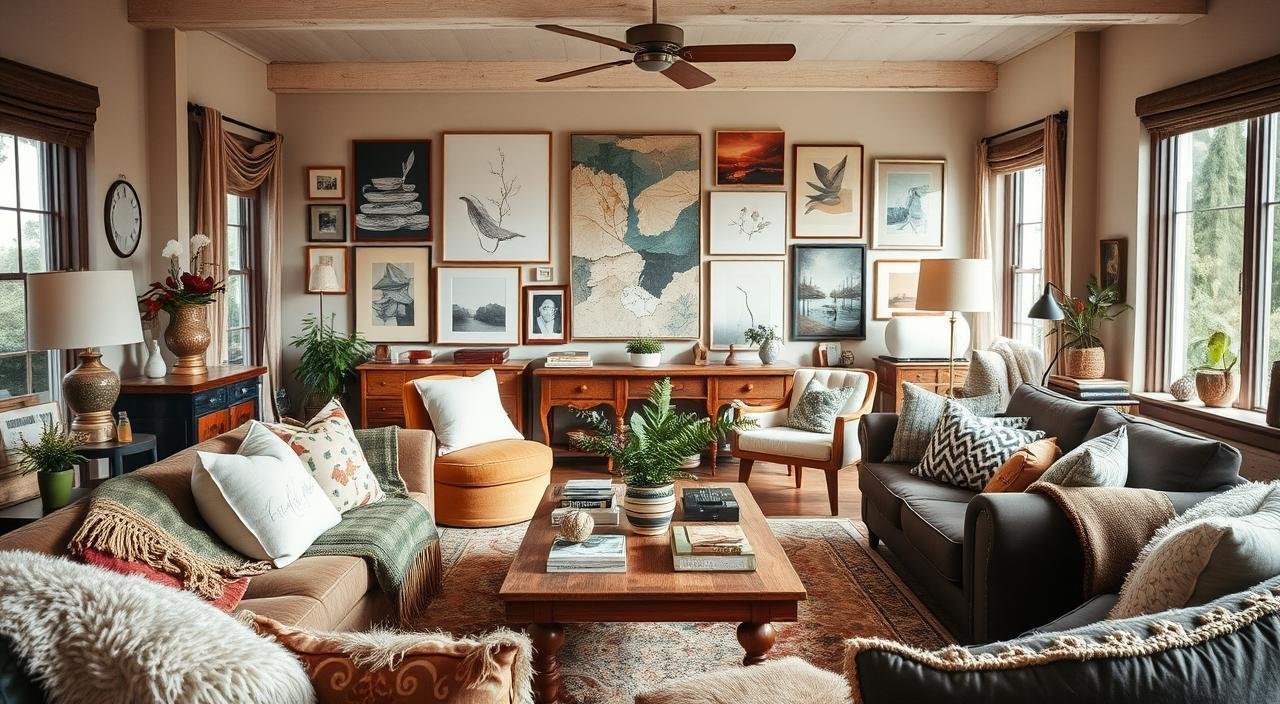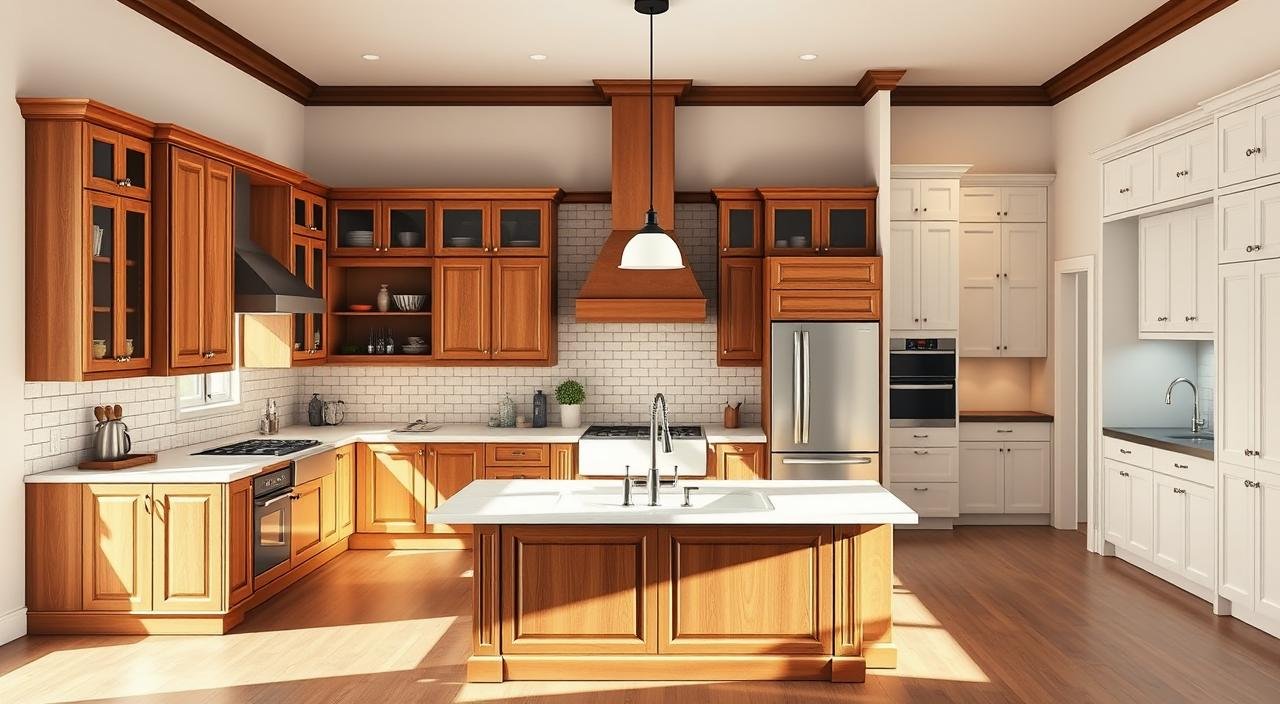Transform Your Space with Cozy Cottagecore Interiors
Ever dream of a home that feels like a storybook? Picture a room bathed in sunlight, with lace curtains filtering the light. Floral patterns adorn every surface, and the air is filled with the scent of fresh herbs. This is the essence of cozy cottagecore interiors, blending rustic charm with hygge-inspired comfort.
This style transcends mere decor; it’s a sanctuary from the world’s noise. It invites you to unwind and find solace in its embrace.
Imagine a living room filled with handwoven baskets and a reclaimed wood coffee table. Thrifted chairs gather around a chunky-knit throw, creating a cozy nook. Cottagecore celebrates layers of texture, history, and nature.
It’s about embracing soft lighting from Edison bulbs, potted ferns climbing shelves, and quilts that hold stories. It’s a space where comfort and character intertwine.
Key Takeaways
- Incorporate natural materials like wood and wicker to anchor spaces with rustic warmth.
- Layer vintage finds with handmade textiles for a lived-in, story-rich aesthetic.
- Pair pastel palettes with earthy tones to balance dreamy vibes and practicality.
- Use plants and floral patterns to mimic the rhythm of nature indoors.
- Upcycle old furniture into functional art for a sustainable, unique look.
Ready to transform your home into a cozy retreat? Cottagecore merges nostalgia with practicality, all without a hefty price tag. Your dreamy, hygge-inspired space awaits.
What Is the Cottagecore Aesthetic?
Imagine a space where every detail whispers “slow living”—that’s the heart of cottagecore decor ideas. This style isn’t just a trend; it’s a love letter to nature and simplicity. It blends rustic charm with cozy comfort, creating spaces that feel both timeless and inviting. At its core, it’s about reconnecting with the earthy textures and vintage interior style elements that remind us of slower, more grounded days.
Rooted in 19th-century pastoral art and literature, cottagecore’s story starts with painters like Constable, who celebrated rural landscapes. Fast-forward to today, and you’ll see this aesthetic thriving on platforms like Pinterest and Instagram. It offers an escape from busy modern life. Think hand-stitched quilts, weathered wooden shelves, and floral arrangements that feel like they grew from the soil itself.
Here’s what defines it:
- Warm neutrals like cream, moss green, and terracotta
- Handcrafted items—think pottery, woven baskets, and embroidered linens
- Layered textiles, from chunky-knit throws to lace curtains
- Vintage finds like farmhouse sinks or antique trunks
| Origins | Modern Evolution |
|---|---|
| 19th-century European pastoral art | Social media-driven DIY projects |
| Textile crafts like quilting and embroidery | Online communities sharing cottagecore decor ideas |
| Rural farmhouse architecture | Urban tiny homes adopting cottagecore vibes |
Remember: This isn’t about perfection—it’s about warmth. Whether you’re styling a small apartment or renovating a countryside home, cottagecore invites you to embrace authenticity over trends. Ready to turn your space into a sanctuary of simplicity? Let’s dive deeper next into how this aesthetic balances nostalgia and practicality.
The Philosophy Behind the Movement
Cottagecore transcends mere aesthetics, embracing a lifestyle of simplicity and intention. It’s about creating hygge inspired spaces that foster comfort and a deep connection with nature. This philosophy encourages us to choose elements that enhance our daily tranquility, not just follow fleeting trends.
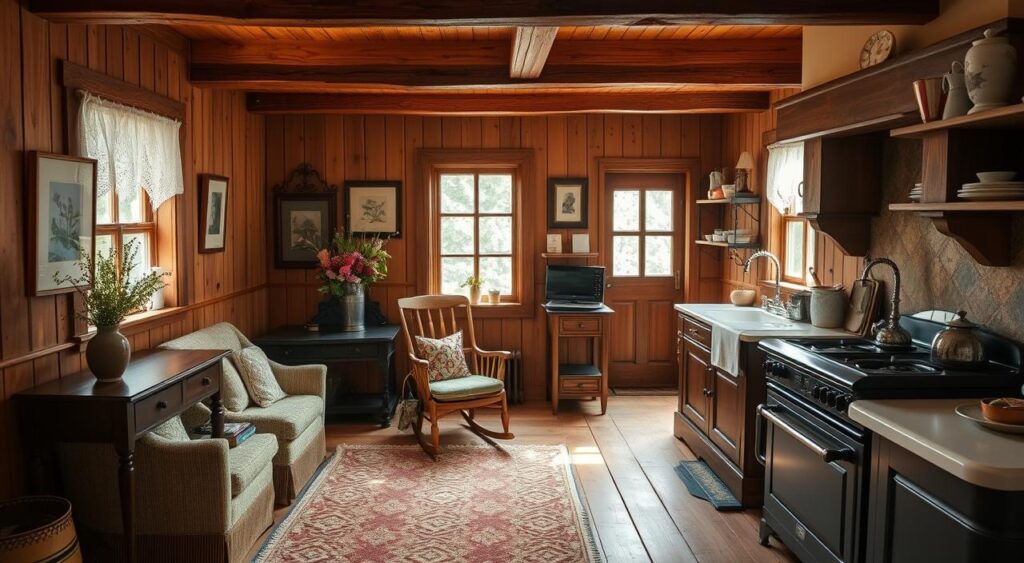
- Sustainability: Prioritize natural materials, upcycled items, and locally sourced decor.
- Mindfulness: Spaces that encourage baking bread, gardening, or sipping tea by a window.
- Inclusivity: Designs now reflect diverse backgrounds, like the global following Noemie Sérieux’s Instagram fosters.
Envision transforming your living room into a quaint cottage interior. It’s not just about aesthetics; it’s about creating a sanctuary. Opt for a vase crafted by a local potter over mass-produced items. Cottagecore draws inspiration from the Cotswolds’ slow-food movement, merging with today’s digital detox and mindful living trends. Even small actions, like choosing linen over synthetic fabrics or growing herbs on your balcony, resonate with this philosophy.
Ready to reimagine your space? Reflect on whether your choices promote a connection to nature or merely decorate a wall. Let’s transform every room into a mindful sanctuary, as inviting as grandma’s quilt. 🌿
Why Cottagecore Has Captured Modern Hearts
“The need for calming, cozy, and safe interiors has never been more necessary than in today’s world,” says design expert Emily Carter, highlighting how cottagecore’s rise mirrors our hunger for sanctuary spaces.
Imagine a room where every texture urges you to slow down. That’s the essence of cottagecore—it’s not just about looks. It’s a response to our fast-paced lives. Cozy farmhouse decor and rustic home design offer a refuge from the digital world. During the pandemic, many transformed their homes into sanctuaries, finding solace in cottagecore’s blend of vintage and natural elements.
- It’s a rejection of “perfect” spaces. Scuffed wood, faded fabrics, and mismatched mugs are the essence. Cottagecore celebrates the beauty of imperfection, making your home a unique narrative, not a sterile display.
- Rustic home design incorporates earthy tones and natural textures to connect us with nature. Think wicker baskets or a thick, hand-knitted throw. These elements anchor us to the earth, away from digital distractions.
- Thrifting and DIY projects allow for personalization without breaking the bank. A flea-market table repainted in soft green can become a focal point, all without spending a fortune.
Cottagecore transcends mere decor; it’s a way of life. It’s about sipping tea in a chipped mug, surrounded by a windowsill herb garden. It’s cozy farmhouse decor that says, “You are welcome here.” Whether you’re renovating a farmhouse or a studio, this style encourages you to slow down, accept imperfections, and create a space that feels like your true home, not a magazine fantasy.
Essential Elements of Cozy Cottagecore Interiors
Let’s dissect the core components of cozy cottagecore interiors to create spaces that feel both deliberate and lived-in. This style marries rustic allure with soft, inviting elements. Think weathered wood, floral patterns, and a variety of textures.
- Natural materials: Reclaimed wood, linen, and wool ground spaces in authenticity.
- Soft color layers: Muted tones like pinks, sage greens, and creams blend with bold hues like sapphire or emerald.
- Vintage textures: Thrifted rugs, hand-stitched quilts, and patinaed brass add history without a hefty price tag.
- Functional comfort: Chunky knit blankets, tufted sofas, and woven baskets focus on ease, as cottagecore is for living, not just aesthetics.
“Cottagecore thrives when you mix worn antiques with fresh blooms—it’s about balance, not perfection.”

Combine chunky-knit pillows with lace curtains or layer floral wallpaper with a rustic oak table. These contrasts make shabby chic home design lively. Opt for furniture with personality, like a painted armoire or a farmhouse table with visible grain. Don’t overlook botanical elements: potted ferns, dried flower wreaths, or a vase of peonies bring life. It’s about layering what you cherish, not buying new. Next, we’ll explore color palettes, but for now, start searching for that vintage side table or a muted-hued rug!
Color Palettes That Define the Cottagecore Look
Imagine strolling through a sun-dappled garden, where warm, earthy neutrals instantly evoke a sense of calm. Let’s explore how these hues craft the vintage interior style charm of quaint cottage interiors. Begin with walls in creamy whites, such as #FFF7F7, or soft taupes. These neutral tones serve as a backdrop for adding rustic charm without overwhelming the space.
- Warm Browns & Creams: Incorporate #795030 for furniture or #FFB6C1 in accent pillows. Picture weathered wood tones alongside linen curtains—a combination that feels like a cozy embrace.
- Muted Greens: Hex codes like #D5ECDB are perfect for kitchen backsplashes or throw blankets. They introduce a fresh forest touch to any room.
- Soft Pinks & Beige Accents: Consider blush pink vases (#FFDAB9) on a farmhouse table or cream-hued rugs (#F7FFFF). These elements balance rustic charm with elegance.
Combine these colors with natural materials like woven baskets or wool throws. For a bolder statement, introduce a floral throw in lavender (#E6E6FA) or honey mustard (#D2690E). Remember, neutrals allow your favorite vintage pieces to shine. What’s your preferred accent color for a cottagecore living room?
Soft Pastels for Dreamy Spaces
Imagine stepping into a room where the walls softly glow like dawn or shimmer with dew’s softness. That’s the enchantment of pastels in cozy cottagecore interiors. These colors aren’t just visually appealing; they’re the key to transforming ordinary spaces into hygge inspired havens that envelop you in warmth.
Consider walls in dusty rose, curtains in sage green, or accent chairs in sky blue. Pastels thrive when paired with natural light, so let the windows be the stars. A pale mint vanity or a buttery yellow throw can ground the room without dominating it. My go-to strategy? Mix pastels with earthy neutrals. A sage-green sofa against a cream wall strikes a balance, while a mint-and-cream quilt adds a playful touch without being too young.

- Paint furniture: Try a powder blue dresser or a blush-pink side table for instant charm.
- Textiles are key—pastel bedding, lace curtains, or embroidered cushions bring that cottagecore romance.
- Add subtle accents: Glassware in soft lavender, porcelain vases in peach, or pastel fairy lights for mood lighting.
Remember, simplicity is key. Even a single pastel accent wall or a mint-green plant pot can change a room’s vibe. Let these colors remind you that cottagecore is about creating a space that feels like home, wrapped in a dream.
How to Layer Colors Effectively
Ever wondered how to blend colors like a pro without clashing? Let’s explore the art of cottagecore’s layered hues. Begin with a neutral base, such as creamy whites or soft beiges, covering 60% of your space. Picture a crisp Platinum White Porcelain floor as your foundation. Then, introduce warm wood tones like distressed oak furniture, making up 30% of your decor. Lastly, add earthy accents in olive, terracotta, or mustard, which should occupy 10% of your space, to infuse life into your area.
- Base layer: Soft neutrals (60%) for calm, breathable spaces
- Secondary tones: Warm wood grains (30%) to add texture and depth
- Accents: Earthy jewel tones (10%) for pops of nostalgic charm
“Layering color is like dressing for a cozy day—start with a neutral sweater, add a textured scarf, then a bold scarf pin!”
Introduce botanical prints on curtains or throw pillows to incorporate nature’s palette into your walls. Blend muted greens from a woven basket with golden tones from a vintage mirror frame. It’s essential to balance your colors. A muted terracotta vase looks stunning against a Volga Blue Granite tabletop, showing how colors can converse without being loud. Cottagecore decor thrives on this gentle harmony. Update your space with seasonal florals or throws to keep it fresh. Remember, cozy farmhouse decor is about layers that feel lived-in and loved, not about perfection.
Natural Materials and Textures in Cottagecore Design
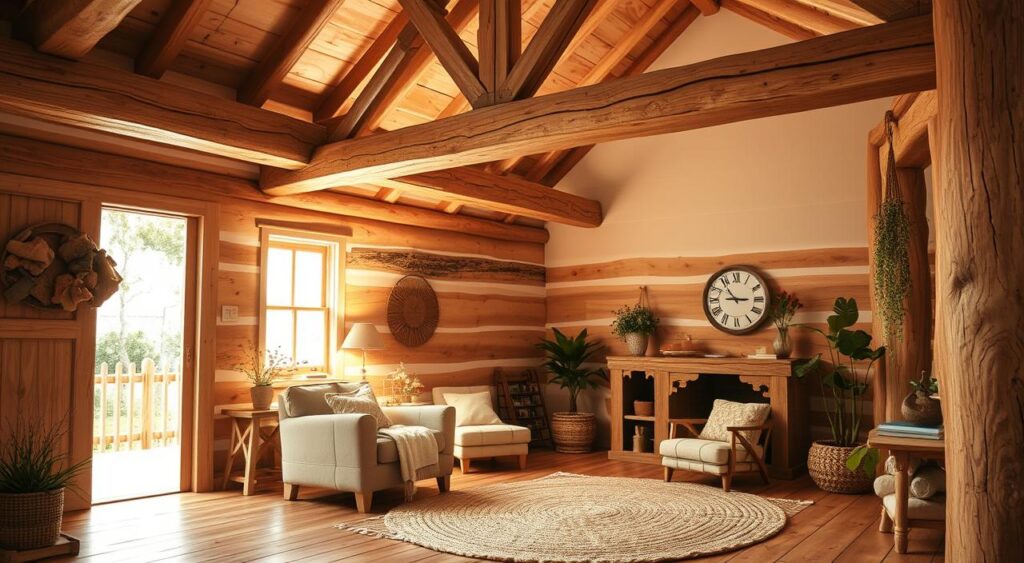
Wood is the heartbeat of cottagecore—it grounds spaces in earthy warmth. Whether you’re aiming for rustic home design or shabby chic home design, wood elements transform rooms into cozy escapes. Let’s explore how to weave wood into every corner of your space.
Begin with the basics: flooring and ceilings lay the groundwork. Exposed beams or wide-plank floors instantly add authenticity. For furniture, choose oak, pine, or reclaimed wood—each offers unique character. Opt for natural finishes like matte stains over glossy lacquers to stay true to the style.
| Wood Type | Style Vibe | Best Use |
|---|---|---|
| Oak | Rustic strength | Floors, dining tables, beams |
| Pine | Shabby chic softness | Shelves, chairs, cabinetry |
| Reclaimed Wood | Time-worn charm | Accent walls, headboards, decor |
- Pair reclaimed wood accents with soft linen textiles for contrast.
- Use whitewashed pine for a shabby chic touch in bedrooms or bathrooms.
- Protect wood with natural oils—like beeswax—for long-lasting beauty.
Even small spaces can embrace wood’s magic. A pine side table or oak picture frame adds instant cottagecore warmth. Mix wood tones by letting one dominate (like dark oak floors) while adding lighter accents (pale pine shelves). The key? Balance rustic durability with cozy layers.
Ready to bring nature indoors? Start with a wooden bench or a distressed dresser—it’s easier than you think! What’s your first wood project?
The Role of Wicker, Rattan, and Other Natural Fibers
Picture your living room with a rattan chair or a wicker storage bench. Suddenly, it feels warmer, lighter, and more connected to nature. These natural fibers embody cottagecore decor ideas, merging function with charm. They transform any room, adding depth without losing practicality.

Wicker and rattan are more than trends; they’re timeless. They bring woven vintage interior style elements like baskets, shelves, or lampshades into your space. These textures enrich your environment, surpassing what wood or fabric can offer. Here’s how to incorporate them effectively:
- Place rattan chairs or stools in sunlit corners for instant coziness
- Hang woven wall baskets as artful storage solutions
- Pair jute rugs with farmhouse sinks to anchor rustic bathrooms
Choosing the right materials can be a bit overwhelming. Here’s a quick guide:
| Material | Best For | Key Benefits |
|---|---|---|
| Wicker | Baskets, chairs | Lightweight, durable, classic cottagecore look |
| Rattan | Lighting fixtures, shelves | Modern-meets-rustic appeal, moisture-resistant |
| Sisal/Jute | Rugs, curtains | Earth-toned patterns, eco-friendly options |
Pro tip: Balance woven fibers with solid wood pieces for a harmonious look. In humid areas like kitchens, choose treated rattan over raw wicker to prevent warping. Don’t overlook DIY projects! Upcycling an old wicker trunk or repainting a rattan pendant light can breathe new life into vintage interior style. These materials are more than decor; they’re stories woven into your space. Begin with a woven basket by your front door, and watch the cottagecore charm grow.
Stone and Clay Accents for Authenticity
Imagine stepping into a space where every surface seems to hold the essence of history. Quaint cottage interiors flourish with materials that connect us to the earth—stone and clay lead the way. These elements bring rustic charm, grounding spaces while adding a touch of warmth.
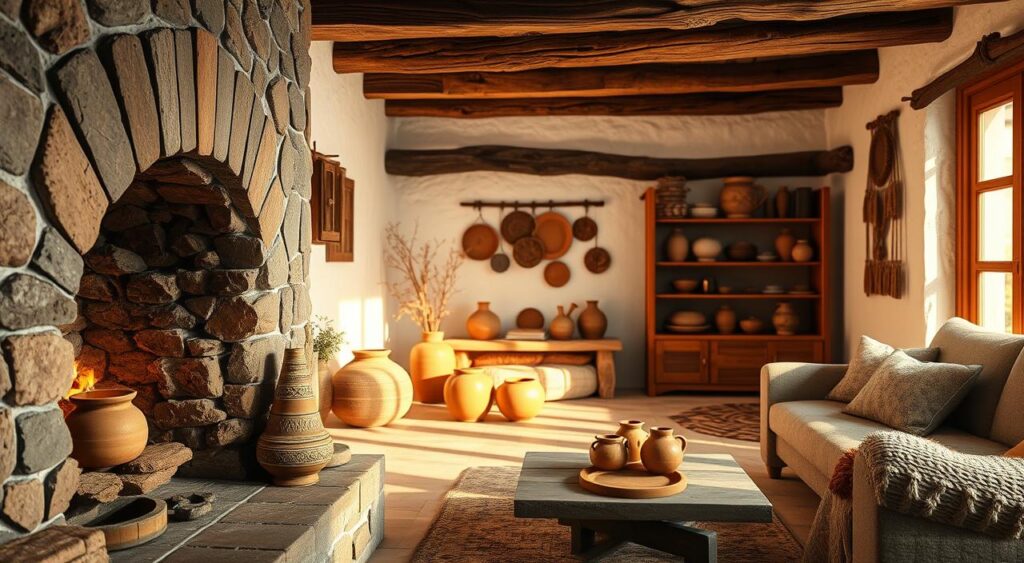
- Handmade terracotta pots for herbs or flowers
- Rustic clay candle holders for soft glow
- Stone trivets under cast iron pans
- Earthenware bowls stacked on open shelves
“Pieces that have had a life before you—and will carry stories forward” — The philosophy of timeless cottagecore design.
Don’t limit yourself to grand changes. A terracotta vase on your mantel or a clay tray on your coffee table can instantly rustic home design vibes. Blend these with woven baskets or linen for a rich texture. Here’s how to begin:
| Material | Use Ideas |
|---|---|
| Stone | Fireplace surrounds, accent tiles, or garden path pavers |
| Clay | Planters, handmade mugs, or decorative tiles |
Finding these materials is easy! Thrift stores are treasure troves for chipped pottery or reclaimed bricks. For new items, look for artisans who craft quaint cottage interiors essentials like salt-glazed jugs. Add greenery like fiddle leaf figs or trailing ivy to enhance that earthy feel.
Quality is key. Even a single clay pitcher on a windowsill can tell a room’s story. It’s about choosing pieces that feel like they belong exactly where they are.
Vintage Finds: Sourcing and Styling Secondhand Treasures
Seeking the ideal vintage piece for your vintage interior style? The excitement of searching for secondhand treasures is where cottagecore magic starts. Imagine it as a treasure hunt—each vase with a crackle or each weathered trunk has a story to tell. Let’s explore where to find these treasures and how to highlight their beauty.
- Thrift spots to explore:
- 9th Street Vintage (NYC) for floral china sets and wicker baskets
- GG’s Social Trade & Treasure Club (Brooklyn) for $20 retro lamps or $75 lace table runners
- Curated and Cozy’s online shop for pre-loved farmhouse pitchers and shabby chic decor
- Brooklyn’s The Six Bells for rustic home accents
While browsing, seek out shabby chic home design must-haves like patina. This soft wear on brass or wood adds character. Ask yourself: Does this item have soul? A chipped plate? That’s character, not a flaw! Combine it with modern pieces for a balanced look.
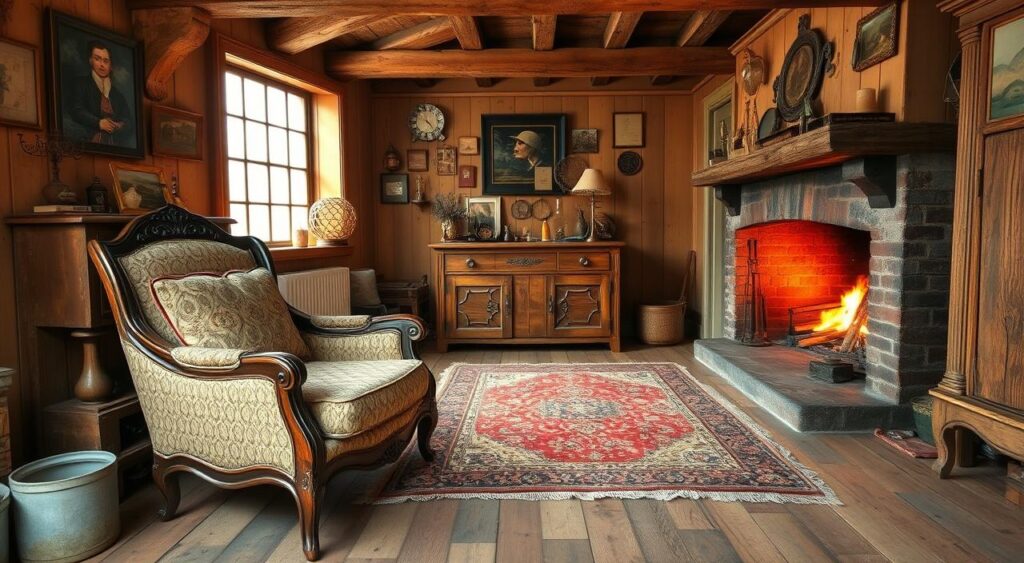
“Slow decorating isn’t just a mantra—it’s how cottagecore thrives. Every flea market find adds layers to your home’s narrative.” – Cottagecore stylist Margot Lane
Pro tip: Blend flea market finds with DIY projects. Paint a thrift-store side table white, then add a vintage floral throw pillow. Flea markets and Facebook Marketplace are treasure troves—check them regularly. And don’t miss estate sales! A 1970s linen dresser with dents? Sand it, stain it whitewash, and it’s cottagecore charm.
It’s perfectly fine to love something “imperfect.” A crackled vase or faded lace curtain adds authenticity. Let your home evolve over time—this is how cottagecore’s romantic, lived-in vibe naturally develops.
Creating a Cottagecore Kitchen: The Heart of Your Home
Your kitchen should feel like a warm hug. Open shelving is key to blending cozy cottagecore interiors with daily life. Picture mismatched dishes stacked like treasures, mason jars for spices, and vintage teapots under soft light. This style is more than decor; it’s a celebration of life’s simple pleasures.
Open Shelving and Display Techniques
Replace upper cabinets with open shelves to display your favorites. Arrange ceramics in rainbow stacks or group by use. Mix floral-patterned plates with copper canisters. Add greenery like a succulent or a vase of wildflowers to bring nature inside. Here’s how to style like a pro:
- Cluster whites and creams for a clean base, then add pops of muted green or terracotta
- Leave empty space between items to keep it airy—cottagecore thrives on balance
- Hang textiles like linen napkins or burlap sacks to add texture
DIY touches are a must! Repaint thrifted frames or distress wood trays—check out this year’s top projects for quick upgrades. Pair with under-cabinet lights (a favorite of 80% of homeowners) to highlight your collections.
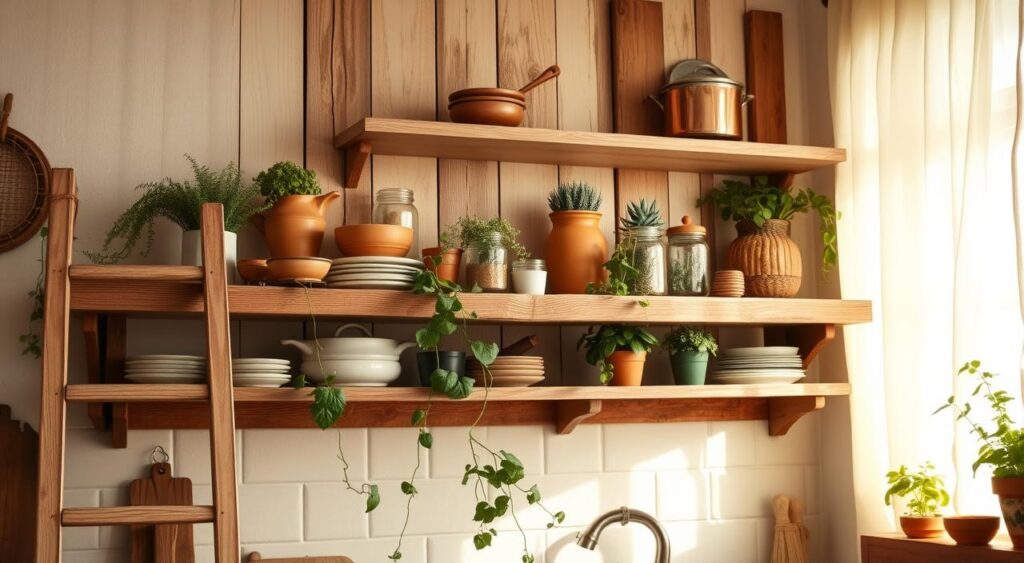
Think of shelves as living galleries. Rotate items seasonally—add pumpkins in fall or fresh herbs year-round. And don’t hide your favorite cookbooks! Stack them face-out or tuck under a lace table runner. Every detail should feel like a hug from your favorite countryside retreat.
Need a focal point? Hang a vintage copper kettle or a handpainted sign above the stove. Cozy farmhouse decor thrives on mixing practicality and prettiness. Let your kitchen tell your story—one jar, one plant, one charming dish at a time.
Farmhouse Sinks and Rustic Hardware
Step into a kitchen where every detail has a story. Farmhouse sinks and rustic hardware are more than fixtures; they’re the heart of rustic home design. These elements transform ordinary spaces into quaint cottage interiors, blending functionality with romance.
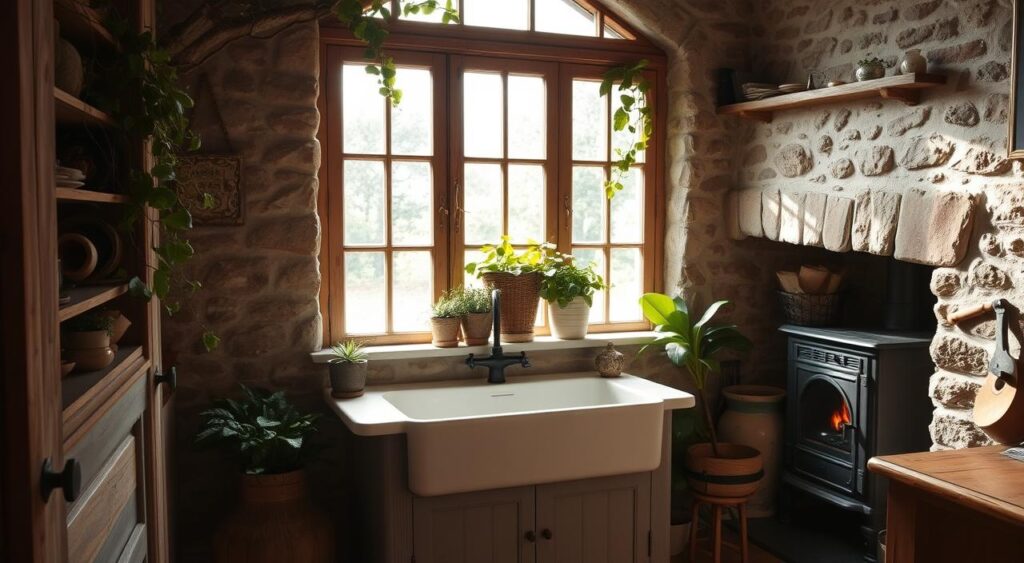
Begin with farmhouse sinks. Their wide, deep basins are perfect for cleaning veggies or displaying flowers. You can choose from:
- Fire clay: Durable and classic, perfect for timeless looks.
- Stainless steel: Modern yet rugged, ideal for small spaces.
- Copper: Adds warmth and develops a beautiful patina over time.
| Material | Pros | Cons |
|---|---|---|
| Fire Clay | Classic look, easy to clean | Heavier, needs proper installation |
| Stainless Steel | Lightweight, affordable | May show scratches |
| Copper | Unique texture, ages beautifully | Higher cost |
Hardware is also key. Choose rustic finishes like oil-rubbed bronze or brushed brass. These metals warm up your space, contrasting with white cabinets or wooden countertops. Even small upgrades, like ceramic knobs or forged iron pulls, can change a room’s feel. Adding open shelving to display vintage mugs or linen towels brings together practicality and charm, making your space inviting.
Remember, mixing materials like stone backsplashes with matte black fixtures adds depth. Whether updating a kitchen or a bathroom, these pieces ground your space in style. Ready to make your home a cozy retreat? Let’s choose the right sink and hardware to achieve it!
Nostalgic Appliances That Blend Function and Style

Picture a kitchen where your fridge, reminiscent of the 1950s, sends you texts about expired milk. That’s the charm of cottagecore appliances. It’s not about being stuck in the past; it’s about combining nostalgia with modern technology. We can transform your appliances into charming characters without losing their functionality.
To select pieces that embody cottagecore decor while meeting 2024 standards, consider the following:
- Retro refrigerators in soft colors (think Smeg!) with advanced cooling systems
- Ceramic stand mixers that serve as decorative pieces
- Enamel-covered toasters with Art Deco designs
| Appliance | Brand Example | Key Features | Price Range |
|---|---|---|---|
| Retro Fridge | Smeg | Rounded edges, pastel finishes | $1,800–$3,500 |
| Stand Mixer | Cuisinart | Vintage-inspired stainless steel | $120–$250 |
| Coffee Maker | Breville | Art Deco geometric patterns | $180–$350 |
Got a stainless steel fridge? No problem! Panel-ready fronts allow you to match your cabinets. Think wood-veneer covers or floral decals. Even small items, like a copper kettle on open shelves, can add to the cottagecore appeal. The aim is to make yesterday’s elegance relevant for today’s needs.
Cozy Bedroom Retreats with Cottagecore Charm
Transform your bedroom into a sanctuary with soft fabrics, floral whispers, and natural light. Cozy cottagecore interiors thrive on layers that soothe the senses. Think floral linens, vintage textiles, and botanical accents that feel like a warm embrace. Let’s craft a space that nurtures rest and romance without breaking the bank.

- Swap plain sheets for floral linens like the Enchanted Garden duvet set—its delicate blooms add romance without overwhelming the room.
- Layer in textures: pair a farmhouse upholstered bed with a distressed white nightstand. Add softness with Egyptian cotton throws or a ruffled canopy for dreamy vibes.
- Anchor with neutral tones (creams, dusty rose, lilac) then let textiles and decor add color. A gallery wall of pressed flowers or country prints ties the room together.
Natural light is key! Position a plush armchair by the window with a wool throw and side table for tea. Add a trailing plant like a pothos to bring the outdoors in. For hygge inspired spaces, swap harsh lamps for a Tiffany-style table lamp and battery-operated candles. Even a set of 3 pink bud vases with fresh blooms creates instant coziness.
Storage solutions matter too! Swap modern dressers for a painted armoire or vintage trunk. Tuck seasonal throws into a wicker basket by the bed. Mix in personal touches—a quilt stitched by hand, a ceramic bird collection—so every detail tells a story. When done right, your bedroom becomes a place where hygge meets practicality, inviting you to slow down and breathe.
Bringing Cottagecore to Your Living Spaces
Transforming your living room into a cozy retreat is achievable. Focus on seating that’s both inviting and stylish. The secret lies in balancing comfort with the rustic charm of cozy farmhouse decor and shabby chic home design. Begin with plush armchairs in soft fabrics like linen or cotton velvet. Opt for oversized pieces that offer comfort without sacrificing elegance.
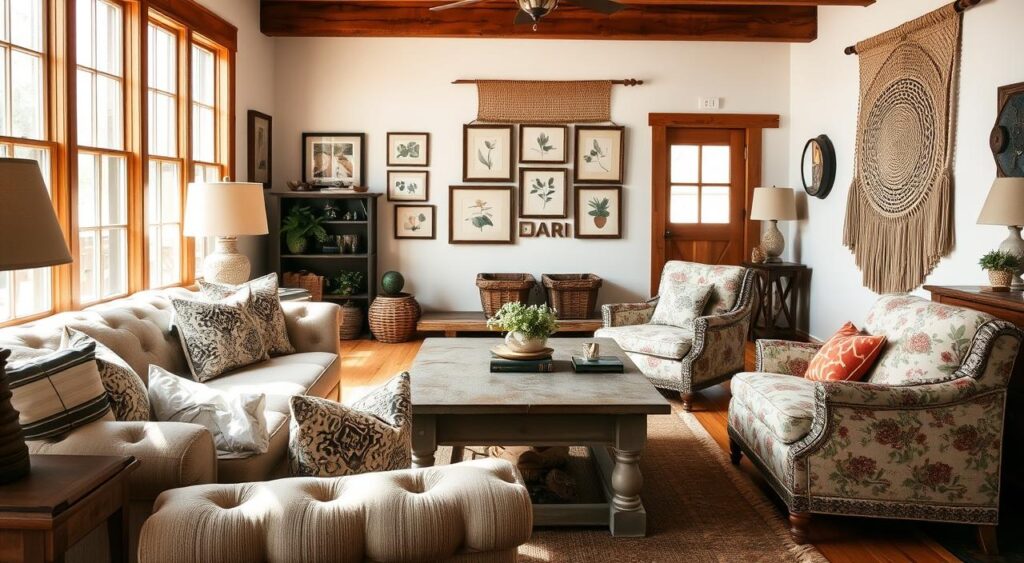
- Pair weathered wood coffee tables with handwoven throws for instant warmth
- Arrange seating in a circle or U-shape to encourage conversation
- Add a daybed or window nook with layered cushions for instant charm
Materials are key. Choose:
| Furniture Type | Material | Style Tip |
|---|---|---|
| Armchairs | Linen upholstery | Choose muted floral patterns in dusty rose or sage |
| Coffee tables | Sanded wood | Leave edges raw for a rustic touch |
| Storage | Rattan baskets | Use as side tables or decor accents |
Lighting is also critical. Layer with:
- String lights draped casually
- Candle holders in mismatched styles
- Table lamps with linen shades
Choosing colors can be tricky. Warm whites and soft greens are ideal. Mixing neutrals creates the dreamy cottage vibe without overwhelming the space. A vintage rug can anchor the seating group, completing the look. Cottagecore is about inviting spaces that feel lived-in and loved, not about perfection.
Layering Textiles for Maximum Coziness
Imagine a room where every surface invites you to linger—a place where textures whisper comfort and patterns tell stories. This is the essence of cozy cottagecore interiors. I’ll guide you through transforming ordinary spaces into hygge inspired spaces with a few simple steps.

- Start with a neutral base: linen curtains or cream-colored rugs create a canvas for bold layers.
- Add chunky knit throws over sofas and chairs—they’re like warm hugs for your decor.
- Mix textures: Pair velvet pillows with woven baskets or wool blankets for a tactile journey.
- Rotate seasonal fabrics—lightweight cotton in spring or chunky knits in winter—to keep your style fresh.
Textiles are like a puzzle. Floral throws over plaid blankets? Yes! A velvet cushion on a rattan chair? Perfect. The key is balance. Need proof? Even a secondhand quilt draped over a bench adds history and coziness. And don’t forget function: layered textiles soften noise, trap warmth, and make spaces feel lived-in—not museum-quality.
Remember: Cottagecore thrives on layers. Start small—a new throw here, a textured pillow there—and watch your space transform. Your future self will thank you for that extra layer of comfort.
Creating Reading Nooks and Intimate Corners
Imagine sinking into a plush armchair with a book, sunlight filtering through sheer curtains—this is the magic of a well-designed reading nook. Quaint cottage interiors thrive on spaces that slow life down. Let’s turn an overlooked corner into your personal sanctuary!
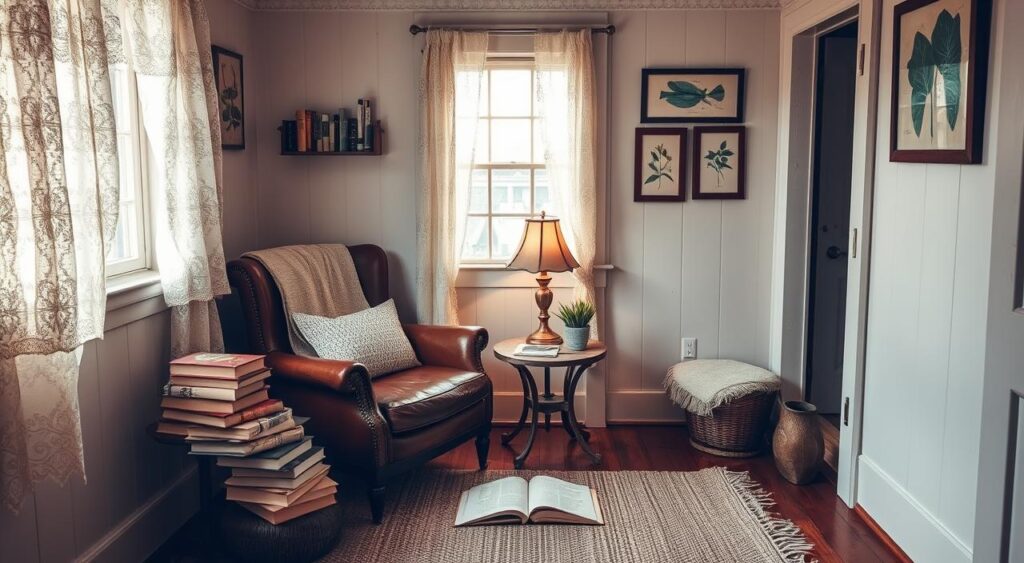
Start by selecting a quiet spot near a window or under a staircase. Rustic home design thrives on repurposing existing furniture: think a vintage trunk as a side table or a reclaimed ladder holding books. Here’s how to craft your oasis:
- Pair an overstuffed armchair with chunky knit throws and a side table for drinks and snacks
- Hang string lights or a wrought-iron candelabra for soft lighting
- Add woven baskets to organize books and textiles without clutter
- Include a small shelf for potted herbs or dried flower arrangements
| Essential Element | Why It Works |
|---|---|
| Vintage-inspired floor lamps | Cast warm light without harsh glare |
| Textured pillows in linen/cotton blends | Encourage relaxation with tactile comfort |
| Hand-painted signs or DIY motto plaques | Personalize spaces without breaking the budget |
“Make Room for Hobbies: Cottagecore isn’t just a design ethos—it’s a lifestyle outlook…”
Layer textiles like embroidered throws over slipcovered chairs, and arrange books vertically on shelves to add visual interest. Add a small rug to define the space—try a hand-hooked wool piece for rustic texture. Mix in personal touches like framed botanical prints or handwritten recipe cards to make it uniquely yours.
Remember, these nooks aren’t just about aesthetics—they’re havens that prioritize joy and mindfulness. Let’s embrace the charm of imperfection and make every corner a place to breathe deeply!
Botanical Elements: Plants and Flowers in Cottagecore Design
Imagine stepping into a space where every corner breathes life—thanks to lush plants and floral touches. Cottagecore decor ideas thrive on connecting indoor spaces to nature, making greenery and blooms must-haves. Even if your thumb isn’t naturally green, there’s a way to bring this style to life!

Begin with easy-care plants like pothos, succulents, or trailing ivy. Hang them in macramé hangers or place them in thrifted terra cotta pots. For floral impact, mix fresh-cut stems in mason jars or dried arrangements in woven baskets. Wildflower bouquets and botanical prints on textiles add instant charm without the upkeep.
- Herb gardens: Basil or thyme in sunny kitchen windowsills add scent and style.
- Wall art: Frame pressed leaves or use floral wallpaper to mimic garden walls.
- Seasonal swaps: Rotate with seasonal blooms—sunflowers in summer, dried eucalyptus in winter.
| Plant Type | Real Plants | Faux Options |
|---|---|---|
| Low-Maintenance | Pothos, Snake Plants | Silk ferns, dried lavender |
| Display Tips | Rotate to sunlight | Pair with rustic frames |
| Cost | Varies by plant | Affordable year-round |
“Plants aren’t just decor—they’re living reminders of nature’s beauty.”
For shabby chic home design, mix real and artificial elements. Layer floral fabrics on upholstery or drapes, and place potted geraniums by doorways. Even a small windowsill can become a cottagecore oasis with a tiny fern and a vintage ceramic pot. Let’s grow that connection between your home and the earth—no green thumb required!
DIY Projects to Enhance Your Cottagecore Home
Ready to transform your space into a personalized cottagecore haven? Let’s explore simple projects that merge cottagecore decor ideas with your creativity. Whether through stitching, painting, or upcycling, each handmade piece infuses your space with unique character.

“The best cottagecore touches are the ones you make yourself—they’re stories waiting to be told.”
Begin with embroidery or cross-stitch. Just grab a hoop, some DMC floss, and create floral motifs for vintage interior style wall hangings. Transform old linen napkins into embroidered table runners with minimal tools. Even simple geometric patterns or initials can bring charm.
- Try cross-stitching phrases like “Home Sweet Home” for a vintage sign.
- Paint floral accents on plain candles or mason jars with acrylic paints.
- Create miniature fairy garden scenes in shadow boxes—add moss, tiny figurines, and fairy lights.
- Press flowers from your garden to frame in antique frames or glue onto journals.
For textiles, blend the new with the old. Darn holes in favorite sweaters, stitch lace trim onto curtains, or braid macramé plant hangers ropes. Online tutorials from sites like Pinterest or YouTube make even complex patterns accessible.
DIY isn’t just about looks—it’s a mindful escape from screens. Every stitch, paint stroke, or repurposed item connects you to cottagecore’s essence. What will you create first? Your home (and hands) will appreciate the effort!
Upcycling Furniture for Vintage Appeal
Ever found a dusty dresser at a thrift store and imagined its full story? Upcycling is more than a trend; it’s the heart of cottagecore’s allure. By transforming overlooked pieces, you infuse your space with the rich, story-filled vibe cottagecore enthusiasts adore. Whether you’re refinishing a side table or distressing a bookshelf, each project brings you closer to achieving that rustic home design magic. It’s a creative stand against the throwaway culture of modern decor!

- Choose sturdy bases: Look for solid wood pieces—even if they’re chipped—to work with their natural textures.
- Embrace shabby chic home design techniques: Soft pastels or floral stencils can instantly elevate plain surfaces. Try milk paint for that weathered finish.
- Add hand-painted details: Simple floral motifs on cabinet fronts turn ordinary into whimsical. Flea markets hide gems waiting for your touch.
“A little chipped paint tells a story better than a new finish ever could.”
Focus on techniques that highlight history. Sand edges of a table to reveal wood grain layers for rustic charm. For doors or dressers, apply milk paint then gently scrape it to expose base colors, mimicking decades of use. Don’t fear imperfections! Cracks or dents? They’re part of the narrative. Pair upcycled pieces with woven baskets or floral-printed linens for deeper cottagecore vibes.
Stores like Wayfair or Etsy offer affordable bases to start. Every stroke of paint or reclaimed detail brings you closer to a home as unique as your taste. Ready to turn that old chair into a statement piece? The possibilities are endless!
Creating Your Own Preserved Botanicals
Bring the outdoors inside with cottagecore decor ideas that turn nature’s beauty into lasting home accents. Preserved botanicals projects let you capture fleeting blooms and foliage for year-round quaint cottage interiors. Let’s get started!
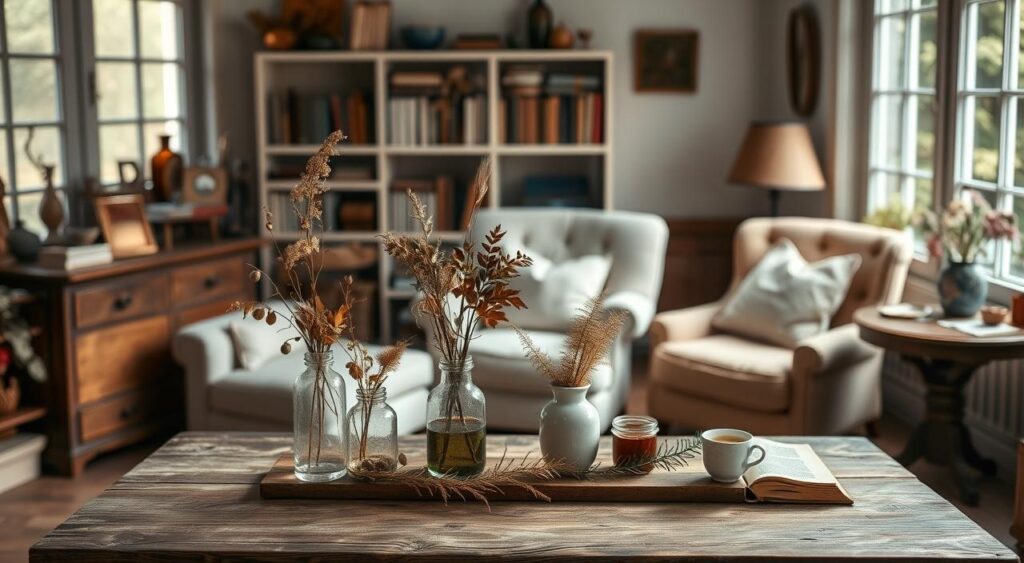
- Choose sturdy flowers like lavender, eucalyptus, or sunflowers—plants that hold shape after drying.
- Hang small bundles upside down in a cool, dark place for air drying. Add glycerin to petals for softer hues.
- Press leaves and petals between heavy books for weeks to create flat specimens for art projects.
| Method | Best Plants | Pro Tip |
|---|---|---|
| Air Drying | Roses, hydrangeas | Strip leaves first for faster drying |
| Glycerin Preservation | Feathery ferns, grasses | Mix 1 part glycerin to 3 water |
| Pressed Art | Maple leaves, pansies | Use parchment paper to prevent staining |
Pair your creations with neutral-toned vases from 17vibes or repurpose thrifted jars. Layer them with woven baskets and linen fabrics to amplify cottagecore charm. For extra flair, frame pressed pieces in shadow boxes or tuck dried blooms into mason jars on bookshelves. These natural accents add warmth without overwhelming space—a key principle of cottagecore’s balanced aesthetic. Let your preserved pieces tell stories of seasons changes while keeping your home feeling fresh. Happy crafting!
Blending Cottagecore with Modern Conveniences
Ever pondered how to merge rustic allure with cutting-edge tech? Let’s explore some solutions! Cozy cottagecore interiors don’t require sacrificing Wi-Fi or concealing phone chargers. It’s about making smart design choices that respect tradition while meeting today’s demands. Yes, you can have a farmhouse-style living room with streaming devices—here’s how.
“The look is void of unusable corners or too-precious finishes… it’s about intentional tranquility and sustainability.”

Begin by hiding, not ignoring tech. Utilize wicker baskets to conceal power strips—pair them with linen-covered outlets! Opt for muted earth tones instead of sleek black cables. For large appliances, choose stainless steel hidden behind distressed wooden panels. Even your smart thermostat can peek out from behind a floral-printed wall sconce.
Try these tricks to harmonize styles:
- Wrap routers in burlap or place them in antique-style cabinets
- Choose farmhouse decor wall art that doubles as cable management
- Mount flat screens behind floral curtains or in nooks with potted plants
- Use vintage-inspired charging stations made from reclaimed wood
| Modern Need | Cottagecore Fix |
|---|---|
| Streaming devices | Store in woven baskets with floral labels |
| Heating systems | Pair with stone accent pieces |
| Phone charging | Use ceramic charging dishes styled like vintage trinket trays |
| LED lighting | Install in sconces with wrought-iron frames |
Remember: Cottagecore thrives on function wrapped in beauty. A farmhouse-style kitchen can have a smart fridge—just add a chalkboard magnet menu or a floral decal to soften its edges. You’re not choosing between charm and convenience—you’re creating a space that’s as practical as it is dreamy.
Seasonal Adaptations for Year-Round Cottagecore Living
Ready to refresh your space without starting from scratch? Let’s transform your cottagecore decor into a year-round journey. Spring and summer demand lighter textures and vibrant colors. Consider linen throws over chunky knits and fresh floral arrangements in thrifted mason jars. Replace heavy curtains with airy gauze to welcome sunlight, maintaining your hygge inspired spaces’ freshness.
DIY projects are your secret weapon here. Try these simple swaps:
- Press flowers from your garden to frame or glue onto shelves
- Hang woven baskets (grab scrap wood tips here) above mantles for spring blooms
- Add potted herbs on windowsills—rosemary or lavender add scent and charm
Stick to natural materials even as seasons shift: rattan side tables work all year, just update with seasonal greenery. Keep it cozy with layered textiles—think cotton blankets over wicker chairs. And don’t forget outdoor spaces! A porch swing with woven cushions becomes a focal point when filled with seasonal flowers.
Need inspiration? Try these easy updates:
- Paint accent chairs in soft pastels for a spring lift
- Swap wool rugs for jute mats in sunlit areas
- Hang fairy lights (LEDs save energy!) in open-air patios for evening ambiance
Every small change keeps your space alive without breaking the bank. Let’s make every season feel like a fresh start—your cottagecore dream home awaits!
Cozy Autumn and Winter Cottagecore Transformations
Autumn and winter bring a magical warmth to cozy cottagecore interiors. Imagine your space enveloped in textures, rich colors, and candlelight. This is when cottagecore truly comes alive. Let’s transform your home into a cozy sanctuary that’s both inviting and intentional.
Begin with textured layers that capture the season’s essence. Replace light linens with chunky knits, faux fur throws, or wool blankets. Combine floral quilts with geometric woven baskets for added depth. Use earthy reds, mossy greens, and warm neutrals to deepen your palette. Think of cinnamon sticks, pinecones, and handwoven rugs. Even a simple gingham throw pillow can tie everything together.
- Hang dried eucalyptus or preserved botanicals to keep that natural vibe year-round
- Add a vintage ceramic vase with evergreen branches for instant charm
- Swap sheer curtains for heavier linen drapes in autumnal tones
| Season | Key Materials | Decor Tips |
|---|---|---|
| Autumn | Rustic wood, burlap, terracotta | Layer woven baskets with cinnamon sticks and faux pumpkins |
| Winter | Velvet textiles, metallic accents, knit blankets | Balance with snowy whites and muted gold tones for contrast |
Lighting becomes essential as days grow shorter. Place candles in vintage holders or string fairy lights along mantles. Art-inspired lamps with handmade ceramic shades are perfect. Keep entryways practical yet pretty with wicker baskets for boots and a wool coat rack near the door.
This isn’t about chasing trends but nurturing spaces that feel like a hug. By layering textures, embracing seasonal colors, and letting light warm your walls, you’ll create a quaint cottage interiors that feels timeless. The colder months are the perfect time to nest—let your home glow with intentional, cozy charm!
Holiday Decorating with Cottagecore Sensibilities
Holiday decorating can harmonize with your rustic home design. Envision festive spaces that feel like warm hugs—think garlands of dried oranges and pinecones, not plastic baubles. The cottagecore approach values handmade beauty and nature’s rhythms. Let’s transform your cozy farmhouse decor into a celebration, keeping its essence intact.
- Swap store-bought ornaments for DIY versions: string popcorn, paint pinecones, or weave burlap bows.
- Layer textiles like chunky knit throws and burlap runners to add texture without overwhelming your rustic home design.
- Repurpose old shutters as a backdrop for floral centerpieces or drape them with fairy lights for a rustic focal point.
- Bring in seasonal greens—pine, eucalyptus, or holly—gathered from your yard or local woods. Tie them with twine for a natural touch.
- Light candles in vintage holders or lanterns. Soft candlelight warms any cozy farmhouse decor space better than harsh LED strands.
Think of holidays as an extension of your cottagecore lifestyle. A handmade wreath on the door, a table scattered with wildflower arrangements, or a mantel adorned with foraged branches and beeswax candles—these details create moments that feel both intentional and joyful. Let your creativity flow, and remember: the best holiday decor is the kind you make yourself.
Budget-Friendly Approaches to Cottagecore Decor Ideas
Cottagecore decor doesn’t need a hefty budget. I’ll show you how to achieve that charming shabby chic look without breaking the bank. The secret lies in valuing authenticity over cost. Thrift stores and flea markets are treasure troves, filled with unique finds like a weathered oak table or a lace curtain set for just $20. Even the smallest tweaks can significantly enhance your space.
“Cottagecore is about authenticity, not extravagance.”
Here are some clever substitutions to get you started:
- Shop Secondhand First: Thrift stores like Goodwill and Habitat for Humanity have floral-printed chairs or wicker baskets at a fraction of the cost of new items.
- DIY Magic: Transform plain shelves into rustic displays with chalk paint—try Farrow & Ball’s “Mizzle” shade for a soft finish. Hang dried lavender bundles from Target for under $10.
- Layer Textiles: Combine thrifted quil throws, hand-knitted blankets, and linen curtains from IKEA for texture without the high price tag.
| Cottagecore Element | Budget-Friendly Option | Where to Find It |
|---|---|---|
| Floral Patterns | Thrift-store linens | Local flea markets |
| Woven Baskets | Repurposed laundry baskets | Home goods stores |
| Vintage Art | Printed Etsy prints | Online marketplaces |
Cottagecore is all about creativity, not cost. Begin with small changes—swap a plain tablecloth for a lace one, or add a macramé hanger from Michaels. Each adjustment brings you closer to your dream aesthetic. And that $95 houndstooth armchair from Facebook Marketplace? It’s a bargain for cottagecore charm! With these tips, you can transform your space without emptying your wallet. The beauty lies in the details, not the price.
Small Space Solutions for Cottagecore Enthuisiasts
Cozy cottagecore interiors and hygge inspired spaces aren’t just for large homes. You can create a warm, inviting retreat even in small spaces. Let’s explore how to maximize charm without losing function.
- Utilize vertical space! Hang botanical wallpapers or floating shelves to add visual interest without taking up floor space.
- Opt for multi-tasking pieces like wicker baskets (for storage) or a vintage trunk (as a coffee table). Mix in thrifted decor but edit ruthlessly—less is more.
- Focus on texture, not clutter. Layer a linen throw over a sofa, drape macramé wall hangings, and add depth with woven rugs under cozy seating nooks.
Begin with light neutrals on walls—creamy whites or soft sage—so spaces feel airy. Add warmth through textiles: a chunky-knit throw, hand-stitched cushions, or a rattan pendant light. For plants, choose trailing ivy or a small fiddle leaf fig in a terracotta pot. Even a 300 sq. ft. apartment can feel like a countryside retreat when every piece serves purpose and beauty.
Try a gallery wall of small prints or thrifted frames—group them in a loose cluster above a bed or sofa. Swap bulky side tables for a ladder-style sideboard that doubles as decor and storage. And don’t forget lighting: a single filament bulb or vintage sconce creates intimacy without overwhelming tight spaces.
Remember—cottagecore thrives on intentionality, not size. Every choice should nurture both style and soul. Ready to transform your nook? Let’s turn that tiny apartment into your own private sanctuary of warmth and charm.
Avoiding Common Mistakes When Creating Cottagecore Interiors
Ever wondered why your cottagecore space feels chaotic instead of cozy? Let’s tackle the top pitfalls to avoid. Cottagecore decor ideas thrive on balance—here’s how to keep your vintage interior style intentional and inviting.
“Focus on meaningful decoration. Choose items that tell a story, use open shelving for display, and ensure everything has its place.” — Design Insider’s 2023 Home Trends Report
1. Edit, don’t hoard. Overcrowded shelves or mismatched florals scream chaos. Stick to 3-5 cohesive items per display. Mix vintage finds with neutral textiles to anchor the look.
2. Light smartly. Layer lamps and candles—warmer tones add warmth without overwhelming the space. Avoid stark overhead lighting that flattens the room’s charm.
3. Anchor with simplicity. Too many bold patterns? Swap in muted tones for walls and upholstery. Let bold florals shine as accent pillows or curtains instead.
4. Curate greenery. Cluster plants in groupings but leave breathing room. A single large potted fern makes a bigger impact than 10 tiny succulents.
Remember: Cottagecore thrives when every piece has purpose. Declutter often, and let light and space breathe. Your vintage interior style will feel timeless, not cramped!
Balancing Whimsy with Functionality
Creating quaint cottage interiors that are both magical and functional requires smart choices. Remember, “Cottagecore might be en vogue, but it should reflect your personal tastes.” Choose decor you love, like floral patterns or vintage finds, but also consider practical solutions. Imagine a cozy farmhouse decor corner with a wicker basket for everyday essentials, or a rustic bench that doubles as storage. These small tweaks transform whimsy into workable spaces.
- Swap delicate silk throws for washable linen upholstery that holds up to spills.
- Hang delicate lace curtains in living areas while using sturdy woven rugs in high-traffic zones.
- Style open shelves with functional items like mason jars for spices or handmade pottery for plants.
Function should be part of the charm. A farmhouse sink with a floral apron adds rustic flair while keeping your kitchen practical. Even delicate botanical wall art can thrive when paired with sturdy frames. Mixing flea-market treasures with modern storage solutions—like a repurposed ladder holding shelves—creates spaces that feel both lived-in and enchanting. And don’t forget lighting: layered lamps with soft hues of gold or muted greens offer both ambiance and practical illumination.
Blending cottagecore’s whimsy with real-life needs isn’t about compromise—it’s about creativity. As you shop or DIY, ask: Does this piece serve a purpose? Does it spark joy? Prioritize items that answer yes to both. With this mindset, your space becomes a haven that’s as functional as it is fantastical. Check out modern luxury design tips for more ideas on merging elegance with everyday use.
When Authenticity Meets Practicality
Ever pondered how to infuse cottagecore into your space without it looking like a Hallmark film set? Let’s dive into creating environments that are as functional as they are aesthetically pleasing.
“The key to working the cottagecore vibe—or really any decor vibe—is not to make your decor too theme-y. A few strategic elements are all you need to embrace it authentically.”
Authenticity transcends mere trend-following; it’s about reflecting your personal narrative. That vintage vase from your grandma? That’s authenticity. On the other hand, a plethora of floral pillows can quickly turn into clutter. Achieving balance is key:
- Integrate rustic home design textures like burlap or weathered wood with modern appliances. This blend of old and new enhances both charm and functionality.
- Combine shabby chic home design fabrics (such as lace table runners) with practical items like durable, easy-to-clean sofas. This harmonious mix elevates both aesthetics and usability.
- Display heirlooms or DIY projects in ways that enhance your daily life. For instance, a woven basket for keys marries practicality with cottagecore charm.
- Consider whether an item adds value to your daily routine. If a wicker chair is too flimsy, opt for a sturdier alternative. Style should never compromise on comfort.
Your home is a dynamic space for living, laughing, and personal growth. Blend cottagecore’s inviting essence with your essential needs. Need a storage solution? A shabby chic trunk serves both as a decorative piece and a practical storage option. For coziness, layer textiles that invite relaxation. Rustic beams can ground a room, but complement them with lamps that support your daily activities.
Remember, the true essence of cottagecore lies in its ability to harmonize with your lifestyle. What small change will you make today to make your space uniquely yours?
Conclusion: Embracing the Timeless Comfort of Cottagecore
Cozy cottagecore interiors are more than a fleeting trend; they’re a path to slowing down and reconnecting with life’s essentials. By combining natural elements like reclaimed wood and soft linens with hygge-inspired designs, you craft a sanctuary. Each piece, from muted greens to mismatched vintage dishes, tells a story of warmth and purpose.
Adding authenticity comes from natural stone tiles from Mosaics.co or a hand-embroidered throw. The charm lies in the imperfections—distressed finishes, botanical accents, and soft candlelight. This aesthetic celebrates comfort over perfection, allowing your space to evolve with your life. Whether it’s a spring floral arrangement or winter’s woolen blankets, it’s all about embracing change.
At its core, cottagecore is about expressing your unique style. Incorporate DIY elements like embroidered cushions or curated plant collections. Blend old with new, combining heirlooms with modern pieces. Every choice, from a handcrafted side table to a cozy nook with string lights, contributes to a space that fosters both beauty and tranquility. Begin with small steps—hang a floral garland, reposition a vintage chair—and watch your home transform into a reflection of your personal touch.
FAQ
What is the cottagecore aesthetic?
How did the cottagecore movement begin?
What are essential elements of cottagecore interiors?
How can I incorporate earthy neutrals into my home?
What role do pastels play in cottagecore design?
How can I effectively layer colors in my cottagecore interiors?
What wood elements should I consider in my design?
How do natural fibers enhance cottagecore aesthetics?
Why are vintage finds important in cottagecore styling?
How should I style my cottagecore kitchen?
How can I create cozy bedroom retreats?
What are some budget-friendly approaches to cottagecore decor?
How can I adapt my cottagecore decor for seasonal changes?

AUTHOR: MARIA JOSE VENTRAMELI
Specialist in Home Design, Architecture, and Trends
With years of experience writing for top home and lifestyle blogs, she now contributes to 17Vibes, offering practical, research-backed insights on renovations, smart technology, sustainable building, and modern living trends. Join our Facebook community here



